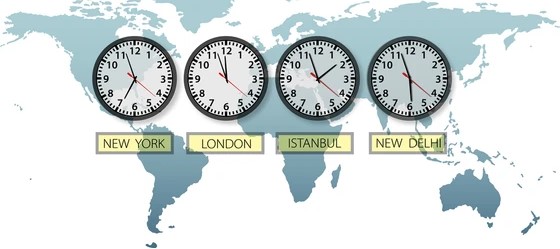Difference Between Local Time and Standard Time

| Aspect | Local Time | Standard Time |
|---|---|---|
| Definition | The time based on the position of the sun at a specific location. | The official time set for a whole region or country, based on a specific longitude. |
| Determined By | The longitude of a place (each longitude has a different local time). | A fixed time zone based on a standard meridian (e.g., IST in India is based on 82.5°E). |
| Changes With Location? | Yes, local time varies from one place to another, even within the same country. | No, standard time remains the same across a time zone. |
| Example | If it is 12:00 noon based on the sun in Delhi, it may be slightly different in Mumbai. | India follows Indian Standard Time (IST), which is UTC +5:30 for the whole country. |
| Used For | Astronomy, sundials, and historical timekeeping. | Official purposes like railways, businesses, and international communication. |
Key Takeaway
- Local time is unique to each place, while standard time is the same across an entire region or country.
- Standard time helps avoid confusion in communication, travel, and daily activities.
Additional facts
🕰 Earth’s Rotation and Local Time
- The Earth rotates 15° of longitude per hour, meaning local time changes by 1 hour every 15°.
- As you move eastward, time increases; as you move westward, time decreases.
🌍 Why Standard Time Was Introduced
- Before standard time, each city had its own local time based on the sun’s position.
- This created confusion, especially for railways and communication.
- In 1884, the Prime Meridian Conference established 24 time zones to solve this problem.
⏳ GMT and UTC – The Global Standards
- Greenwich Mean Time (GMT) was the first global standard based on 0° longitude (Prime Meridian) in Greenwich, UK.
- Today, Coordinated Universal Time (UTC) is used as the worldwide reference for timekeeping.
🌅 Time Zones and Daylight Saving Time (DST)
- Some countries adjust clocks during certain months for Daylight Saving Time (DST) to make better use of daylight.
- India does not follow DST, while countries like the USA, UK, and Canada do.
📍 India’s Standard Time (IST)
- Indian Standard Time (IST) is UTC +5:30 and is based on 82.5°E longitude (near Mirzapur, Uttar Pradesh).
- India has one time zone, while larger countries like the USA, Russia, and Australia have multiple time zones.
🗺 Local Time Variations in Large Countries
- Countries with a large east-to-west spread experience significant local time differences.
- For example, China follows one standard time zone (Beijing Time), but the local time difference can be as much as 3 hours in different regions.
FAQs
Local time is based on the sun’s position at a specific location, which changes as you move across the globe. Standard time is the official time used across a whole region or country, based on a specific longitude or time zone.
Countries use standard time to avoid confusion, especially for travel, communication, and business. It ensures that everyone in a time zone follows the same time, making scheduling and coordination easier.
Standard time is typically set based on a specific meridian (longitude), with the Greenwich Meridian (0°) being the starting point. Countries choose time zones according to their geographical location relative to UTC (Coordinated Universal Time).
No, India does not follow daylight saving time (DST). The country uses Indian Standard Time (IST) throughout the year, which is UTC +5:30.
The Earth is divided into 24 time zones, each representing a 15° longitudinal segment. As the Earth rotates, the time changes, and these time zones help maintain consistency in timekeeping across vast geographical areas.








